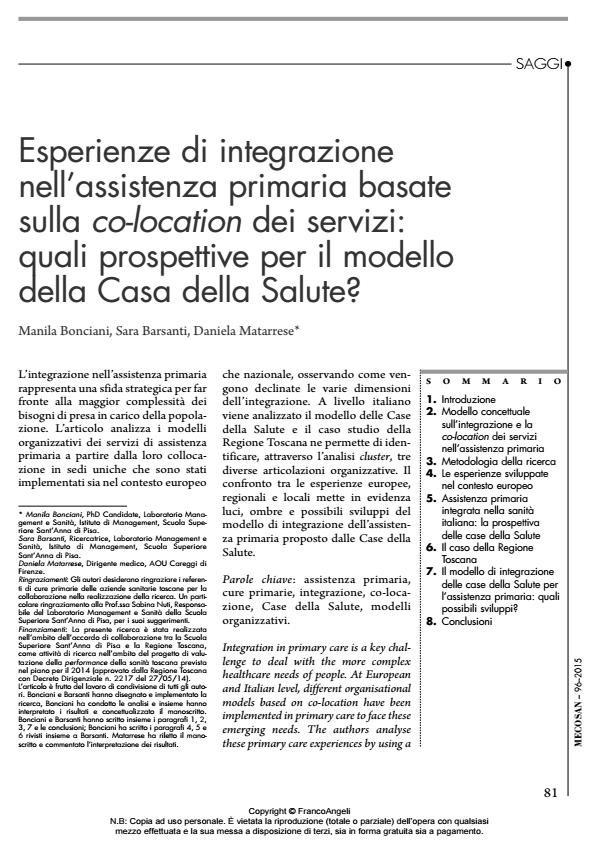Esperienze di integrazione nell’assistenza primaria basate sulla co-location dei servizi: quali prospettive per il modello della Casa della Salute?
Titolo Rivista MECOSAN
Autori/Curatori Manila Bonciani, Sara Barsanti, Daniela Matarrese
Anno di pubblicazione 2016 Fascicolo 2015/96
Lingua Italiano Numero pagine 41 P. 81-121 Dimensione file 471 KB
DOI 10.3280/MESA2015-096005
Il DOI è il codice a barre della proprietà intellettuale: per saperne di più
clicca qui
Qui sotto puoi vedere in anteprima la prima pagina di questo articolo.
Se questo articolo ti interessa, lo puoi acquistare (e scaricare in formato pdf) seguendo le facili indicazioni per acquistare il download credit. Acquista Download Credits per scaricare questo Articolo in formato PDF

FrancoAngeli è membro della Publishers International Linking Association, Inc (PILA)associazione indipendente e non profit per facilitare (attraverso i servizi tecnologici implementati da CrossRef.org) l’accesso degli studiosi ai contenuti digitali nelle pubblicazioni professionali e scientifiche
L’integrazione nell’assistenza primaria rappresenta una sfida strategica per far fronte alla maggior complessità dei bisogni di presa in carico della popolazione. L’articolo analizza i modelli organizzativi dei servizi di assistenza primaria a partire dalla loro collocazione in sedi uniche che sono stati implementati sia nel contesto europeo che nazionale, osservando come vengono declinate le varie dimensioni dell’integrazione. A livello italiano viene analizzato il modello delle Case della Salute e il caso studio della Regione Toscana ne permette di identificare, attraverso l’analisi cluster, tre diverse articolazioni organizzative. Il confronto tra le esperienze europee, regionali e locali mette in evidenza luci, ombre e possibili sviluppi del modello di integrazione dell’assistenza primaria proposto dalle Case della Salute.
Parole chiave:Assistenza primaria, cure primarie, integrazione, co-locazione, Case della Salute, modelli organizzativi
- Innovatori, indecisi, bisognosi o autonomi. I medici di medicina generale tra integrazione e accountability Sara Barsanti, Manila Bonciani, Federico Vola, Luca Pirisi, in MECOSAN 98/2016 pp.9
DOI: 10.3280/MESA2016-098002
Manila Bonciani, Sara Barsanti, Daniela Matarrese, Esperienze di integrazione nell’assistenza primaria basate sulla co-location dei servizi: quali prospettive per il modello della Casa della Salute? in "MECOSAN" 96/2015, pp 81-121, DOI: 10.3280/MESA2015-096005